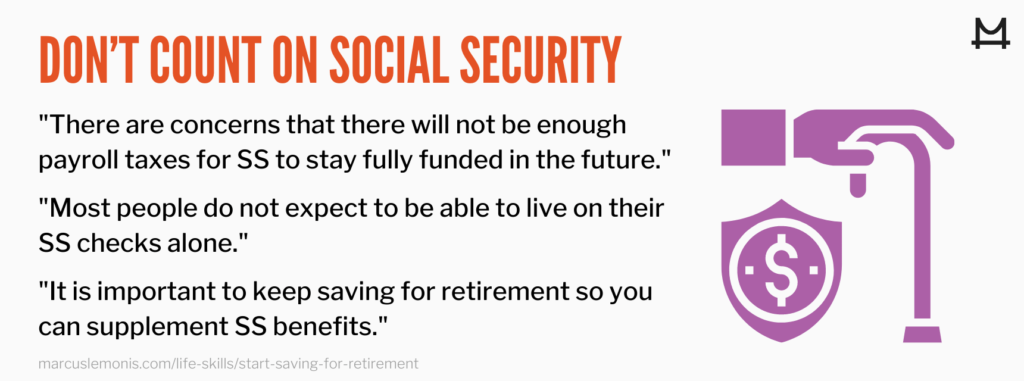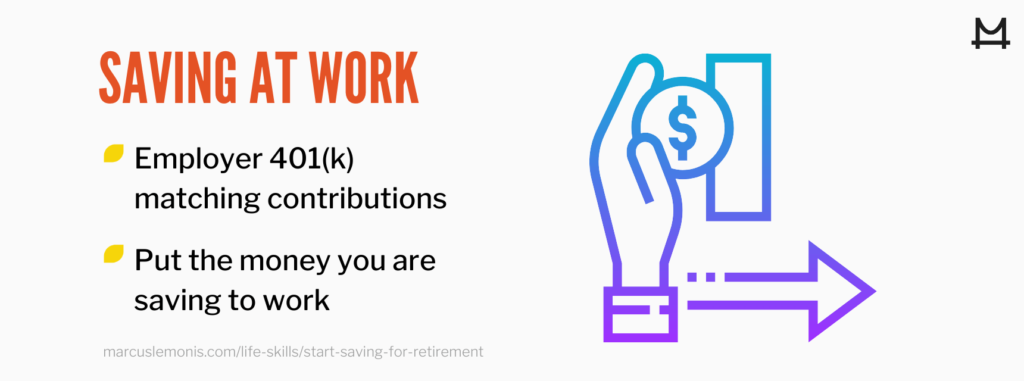The voices you hear telling you to save for retirement are getting louder, and sometimes you just want them to stop. You know you should be saving for retirement, but that point in time seems light years away, and the bills are due now. The reality is that saving for retirement may be easier than you think. Let’s clear a few things up to help sort this out.
Start Saving For Retirement Now
The rationale behind starting to save when you are young is that it takes decades to build a nest egg sufficient enough for you to stop working one day. The money you save today earns interest, and that interest earns interest. In essence, your money makes money for you. Once you get into the habit of saving, it becomes second nature.

The trick is to never let the money pass through your hands. If your employer offers a savings plan, arrange for a percentage of your pay to be taken directly out of your check. This automatic deduction forces you to budget your expenses based on earnings after savings. Because the deduction is a percentage, the amount increases automatically when you receive merit or promotional increases. You can request annual automatic contribution increases to go into effect around the time your company gives out merit increases. It is a seamless process that multiplies the benefits of saving for retirement.
If your employer does not offer a savings plan, there is an alternative to putting aside money that is equally effortless. Ask your employer if split direct deposit is an option. If so, you can authorize Payroll to electronically transfer a fixed amount from each paycheck to your savings account. The remainder will be directed to your checking account. Review your monthly expenses to be sure the amount transferred to checking covers your monthly expenses plus some extra spending money. Do your best to avoid touching the amount in your savings account.

Both of these options remove the stress of figuring out how, and how much, to save every time you get paid. Arranging automatic transactions will free you from having to consciously set money aside each pay period, making saving for retirement happen without you having to think about it.
5 Types of Retirement Funds
1. Defined Contribution Plans
At one time, it was common for people to work for a company their entire working life and leave with a pension. Pension plans are defined benefit plans. These plans are funded by employers, enabling employees to retire with a set monthly income for life. However, when employees leave the organization before becoming eligible for a pension, they do not receive anything.

Today, most of corporate America has abandoned pension plans and adopted defined contribution plans. These plans do not guarantee any benefit amount. But you and your employer can both contribute to it, you can choose the amount of your contribution, and you control how the money will be invested. It is also portable, meaning that whenever you leave the company, you can roll over all your contributions and the vested portion of the company’s contributions into a specific type of fund.
2. The 401(k) Plan
A 401(k) plan is a defined contribution plan. Not only is this a convenient method of saving for retirement, but most companies match employee contributions up to a certain percentage. The other benefit is that your income taxes are calculated after the deduction. So not only is this a great savings vehicle, it offers tax benefits as well. Income taxes are deferred until you withdraw the funds.

Some companies offer a 401(k) Roth plan, which allows you to contribute after-tax money. This means that the money transferred into the fund has already been taxed. Although you would not receive the tax deferral benefit of a traditional 401(k) plan, you will reap the rewards when you withdraw money in retirement with no tax liability on either the investment or the interest earned.
In case you are wondering about the name, 401K, this refers to section 401 of the Internal Revenue Code (IRC). In 1978, Congress passed the Tax Revenue Act, adding paragraph k to section 401, which launched the framework for the plans implemented today. The provision went into effect January 1, 1980.

3. The 403(b) Plan
A 403(b) plan is a tax-sheltered annuity plan. This method of saving for retirement is available to people who work for public schools, tax-exempt organizations as well as certain ministers and chaplains. Like the 401(k) plan, there is a pretax and after-tax model, and the employer can contribute a matching amount.
4. Individual Retirement Account (IRA)
An IRA is a retirement savings account you can open with a bank or brokerage firm. There are several different types:
- Traditional: All or part of your contribution may be tax deductible.
- Roth: Contributions are not tax deductible.
- SIMPLE (Savings Incentive Match Plan for Employees): This IRA can be established by small employers not sponsoring a retirement plan. Sole proprietors are also eligible.
- SEP (Simplified Employee Pension): For self-employed workers. Keogh, a term you may come across in reading about investments, was an older investment plan for self-employed individuals that is no longer used.
5. Social Security Benefits
Qualification for Social Security (SS) benefits is based on working and paying Social Security taxes throughout your working lifetime. Under current law, you can apply for benefits at age 62. Full retirement age begins at age 66 or later, depending on your year of birth. You do not need to be retired to collect these payments.


Don’t Count on Social Security
SS is funded by payroll taxes collected from you and your employer. There are concerns that there will not be enough payroll taxes for SS to stay fully funded in the future. But even if Congress acts to ensure funding, most people do not expect to be able to live on their SS checks alone. It is still important to keep saving for retirement so you can supplement SS benefits.
“Your Social Security Statement” is a document available to you online when you register on the Social Security Administration website. The SSA recommends that everyone review their statement annually to be sure the earnings recorded are correct. The statement will include a projection of your benefits at retirement based on your earnings to date. Retain your W-2 and 1099 tax forms throughout your working career for backup just in case you need to question the earnings documented in your statement.


Saving at Work
Your Employer Might Offer a Match
If your employer offers a 401(k) with matching contributions, try to contribute at least enough to take advantage of that benefit. For example, if you have an opportunity for a 50% match up to 6%, then contribute at least 6% of your salary. More is better if possible. Any contributions and interest earned are tax deferred. If you leave this money on the table, you are missing out on an opportunity to build your savings faster.
Put the Money You are Saving to Work
Expedite saving for retirement by having your money make money for you. To protect your investment during stock market declines, diversify across stocks, bonds and cash. The percentage in each investment vehicle should align with your proximity to retirement age. The rule of thumb is that when you are younger, invest a higher percentage in stocks because you have enough years to ride the cycles of the stock market. As you are nearing retirement and have less time to recover from stock market swings, shift to lower risk options.

When you first sign up for a 401(k) plan, you will be presented with investment options, and your decisions should be based on your risk tolerance and inclination to control your investments. Some people want to be hands-on, building a retirement portfolio based on individualized investment decisions. People who prefer to have money managers do this for them would select target date funds.
A target date model is a blend of assets, typically stocks, bonds and short-term investments, in one fund. All you need to do is select your projected year of retirement, and investment analysts monitor and balance the funds for you based on that target date. With this approach, you do not need to pick stocks yourself or keep checking how the stocks are doing.
In fact, it is best if you leave your accounts alone at that point because a bad day in the stock market may cause you to panic and make rash decisions. Saving for retirement should be a long-term plan.


Do Not Cash Out Before You’re Ready to Retire
Not only will cashing out early undermine your efforts toward long-term savings, but the IRS imposes a 10% penalty for withdrawals from retirement funds before the age of 59 1/2. Additionally, you will need to pay tax on the money withdrawn from tax-deferred plans. Once you reach age 72, the IRS requires that you begin to take distributions.
Save for the Future
Any of the options covered in this article will be a step in the right direction. No one can predict the future, but everyone can save for it.
This article is informational only and subject to errors or omissions. As with any legal or regulatory advice, please consult your legal counsel or tax advisor to make sure you are in compliance with all and any federal, state, city or county rules and regulations. More
- Have you started saving for retirement?
- How do you plan to save your money?
DOL.gov. (n.d.). FAQs about retirement plans and ERISA [pdf file]. Retrieved from https://www.dol.gov/sites/dolgov/files/EBSA/about-ebsa/our-activities/resource-center/faqs/retirement-plans-and-erisa-compliance.pdf
IRS.gov. (2020, September 19). Retirement plans FAQs regarding 403(b) tax-sheltered annuity plans. Retrieved from https://www.irs.gov/retirement-plans/retirement-plans-faqs-regarding-403b-tax-sheltered-annuity-plans#:~:text=A%20403(b)%20plan%2C,their%20salary%20to%20the%20plan
IRS.gov. (2020, October 13). Individual retirement arrangements (IRAs). Retrieved from https://www.irs.gov/retirement-plans/individual-retirement-arrangements-iras
Social Security. (n.d.). Retrieved from https://www.ssa.gov/





